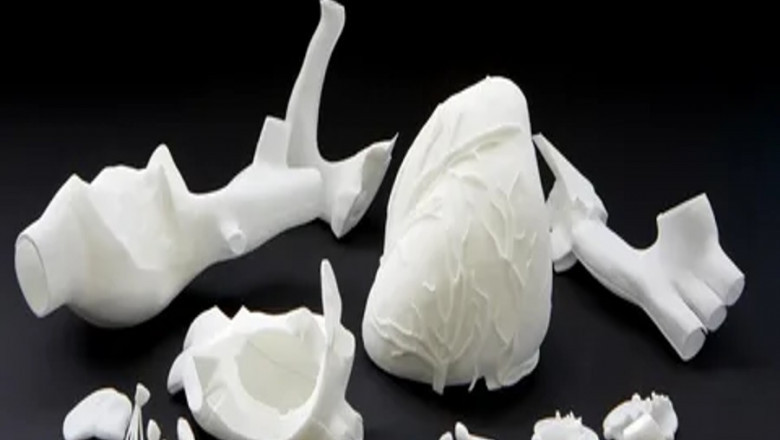views
What are Bioceramics?
Bioceramics refer to ceramic materials that interact with biological systems. They are designed to replace hard tissues like bones or teeth, or to be integrated into soft tissues. They are used in medical applications like orthopedic and dental implants as well as reconstructive surgeries. Some key properties include biocompatibility, bioactivity, and mechanical properties similar to bones. The three main classes of them are bioinert, bioactive, and bioresorbable ceramics.
Bioinert Ceramics
Bioceramics or Bioinert or bioinactive ceramics do not bond chemically to living bone or soft tissue. They are highly insoluble and stable materials like alumina and zirconia. While bioinert ceramics do not chemically bond to tissues, a fibrous bone capsule forms around the implant to securely anchor it. Since they do not directly bond to bone, bioinert ceramics rely on friction fit for fixation. Some advantages of bioinert ceramics include excellent mechanical properties, corrosion resistance, and long-term stability in the body. However, the lack of chemical bonding to tissues can lead to loosening over time under load. Examples of bioinert ceramics used in implants include alumina and zirconia hip joints and dental crowns or bridges.
Bioactive Bioceramics
Bioactive ceramics have the ability to chemically bond to living tissues through the formation of strong interfacial bonding between the implant and host tissues. This occurs via the formation of a crystalline hydroxycarbonate apatite (HCA) layer on the ceramic surface which chemically and structurally resembles bone mineral. When in contact with body fluids, bioactive ceramics such as glass ceramics and hydroxyapatite release ions that stimulate osteoprogenitor cells to grow and differentiate into bone-forming cells. These cells then deposit new bone directly on the surface of the implant, till it is fully integrated with surrounding bone. As a result, bioactive ceramics exhibit excellent osteoconductivity and develop a live bone-implant interface. Common bioactive ceramics used as bone grafts or coatings on prosthetic joints include hydroxyapatite, bioglass, and glass ceramics.
Bioresorbable Ceramics
Unlike bioinert and bioactive ceramics which are designed for long-term implantation, bioresorbable ceramics are meant to degrade gradually and be replaced by bone tissue. As new bone forms, the ceramic scaffold resorbs and disappears. Examples include calcium phosphates like tricalcium phosphate (TCP) and monocalcium phosphate (MCP). During resorption, calcium and phosphate ions are released which can stimulate new bone formation. Bioresorbable ceramics find use as temporary bone void fillers and scaffolds for bone regeneration. Their degradation rate is one of the key design parameters to be optimized based on the healing process. While they eliminate the need for implant removal surgery, controlling the resorption rate is challenging.
Types of Materials
Some commonly used bioceramic materials include:
- Hydroxyapatite (HA): Chemically resembles mineral component of bones. Excellent osteoconductivity but brittle. Used as bone graft material and bone filler.
- Tricalcium phosphate (TCP): More soluble than HA and resorbs faster. Used as scaffold for bone regeneration. Comes in alpha and beta forms with different resorption rates.
- Bioglass: Amorphous silica-based material that bonds to tissue. Useful as coating to improve bioactivity of other ceramics.
- Glass Ceramics: Developed from bioglass with better mechanical properties. Examples include A/W glass ceramic and Biosilicate glass ceramic.
- Aluminum oxide (Al2O3): Commonly used bioinert ceramic. Has high strength, toughness, and hardness making it suitable for implant components.
- Zirconia (ZrO2): Bioinert ceramic used as an alternative to Al2O3 in joint replacements. Superior fracture toughness allows thinner sections for improved functionality.
Applications
Some key applications of it include:
- Orthopedic implants - Artificial hip/knee joints, fracture fixation plates/screws, bone graft substitutes
- Dental implants - Tooth roots, bridges, fillings
- Tissue engineering - Scaffolds for bone regeneration, carriers for drug/cell delivery
- Cardiovascular implants - Heart valves, stents
- Plastic & reconstructive surgery - Dermal/maxillofacial bone repair
- Neurosurgery - Cerebral aneurysm repair, spinal fusion
- Ophthalmology - Lenses, shields for eye/orbital reconstruction
The future of bioceramics looks promising with ongoing research to develop materials with enhanced mechanical integrity, controlled resorption properties, advanced surface modifications for faster integration with host tissues, and potential new therapeutic applications. With continued progress, these revolutionary materials could greatly benefit patients worldwide.
For Deeper Insights, Find the Report in the Language that You want.
About Author:
Priya Pandey is a dynamic and passionate editor with over three years of expertise in content editing and proofreading. Holding a bachelor's degree in biotechnology, Priya has a knack for making the content engaging. Her diverse portfolio includes editing documents across different industries, including food and beverages, information and technology, healthcare, chemical and materials, etc. Priya's meticulous attention to detail and commitment to excellence make her an invaluable asset in the world of content creation and refinement. (LinkedIn- https://www.linkedin.com/in/priya-pandey-8417a8173/)






















Comments
0 comment